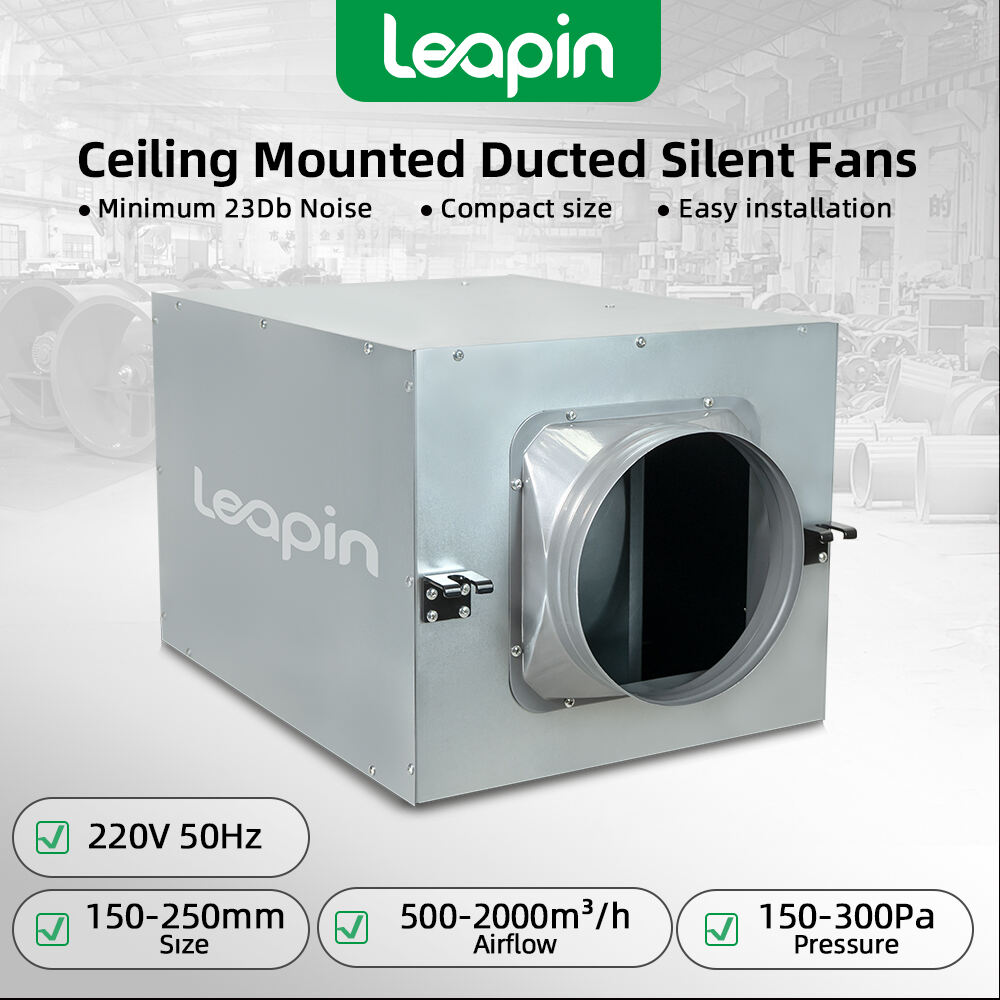Key Features of Inline Duct Fans: What You Need to Know
Core Functionality of Inline Duct Fans
How Inline Duct Fans Enhance Airflow Efficiency
Inline duct fans are specifically designed to boost the airflow within HVAC systems, thus increasing the overall efficiency. By improving the movement of air, they enhance the distribution of hot or cold air throughout the space. This is crucial for combating issues related to uneven temperature distribution, often caused by high static pressure in ducting systems. Inline duct fans, including variations like the 'inline centrifugal fan', work to reduce these pressure levels, thereby facilitating smoother air distribution. Implementing these fans leads to both enhanced airflow and improved energy efficiency.
Balancing Temperature and Humidity Control
Inline duct fans play a vital role in maintaining balanced levels of temperature and humidity, critical for comfort in both residential and industrial environments. They excel at reducing moisture buildup within air ducts, which not only enhances comfort but also promotes a healthier living space by preventing mold formation. A study noted energy savings reach up to 30% with proper fan utilization, underscoring the cost-effectiveness of using inline duct fans for temperature and humidity control. Adequate control of indoor climate ultimately leads to reduced energy expenses and an improved living environment.
Noise Reduction Technology in Modern Models
Recent technological advances have significantly improved the noise levels of inline duct fans, making them much quieter and more appealing for residential use. Modern models often incorporate features like sound insulation and vibration-dampening mounts, effectively reducing operational noise. Comparative reviews highlight that these new models can decrease sound levels by up to 50%, a substantial benefit for those in noise-sensitive areas. The addition of noise reduction technology has made inline duct fans perfect for maintaining a peaceful environment without compromising performance.
Key Features of High-Performance Inline Duct Fans
Low Noise Operation for Residential Use
High-performance inline duct fans are tailored for low noise operation, making them ideal for residential environments. These fans often incorporate ECM (Electronically Commutated Motor) technology, which helps minimize noise without sacrificing airflow efficiency. I've noticed that many homeowners appreciate this feature, as customer reviews frequently underscore the importance of a quiet ambience in enhancing home comfort.
Compact Design and Space-Saving Benefits
Many inline duct fans are designed to be compact, facilitating easy installation in confined areas. This space-saving design is especially beneficial when retrofitting existing ventilation systems, as it eliminates the need for extensive modifications. Industry experts often commend how compact these fans are while still maintaining robust airflow performance, a crucial consideration for effective ventilation.
Durable Construction with Corrosion-Resistant Materials
High-quality inline duct fans are often constructed with corrosion-resistant materials, significantly extending their lifespan. This durability is not only vital for industrial applications but also reduces maintenance costs and the frequency of replacements. Trust in these products is often supported by manufacturer guarantees, which emphasize the role of material choice in long-term performance.
Energy-Efficient Motor Technologies
Modern inline duct fans are distinguished by their energy-efficient motors, designed to consume less power while delivering high performance. This aligns with commercial energy efficiency standards, underscoring the significance of sustainable design. Energy audits often highlight the cost savings these fans offer, making them an excellent choice for both residential and commercial applications seeking to reduce electricity consumption.
Top Inline Duct Fan Models for Industrial and Residential Applications
DPT Series Duct-Type Silent Fan: Low-Noise Ventilation
The DPT Series Duct-Type Silent Fan is noteworthy for its ability to deliver low-noise ventilation, making it an excellent choice for environments requiring quiet operation. These fans are suitable for settings ranging from residential spaces to light commercial applications. With noise output among the lowest available, they enhance comfort without sacrificing performance. The dual-suction design and high-quality motor contribute to maintaining a serene atmosphere, whether used in homes, offices, or entertainment venues. Discover more about this robust and silent solution here.
EC Motor Silent Inline Fans CDC-E Series: Energy-Saving Powerhouse
The CDC-E Series fans incorporate advanced ECM technology, resulting in exceptionally energy-efficient performance. These fans significantly reduce energy consumption without compromising airflow, a feature that users have noted for its impact on lowering energy bills. Tests show that the CDC-E series provides superior airflow rates while maintaining quiet operation, making them ideal for both industrial and residential installations. By harnessing top-tier technology, these fans set a high standard in energy savings and operational excellence. For more details, visit the product page here.
Duct Silent Cabinet Box Inline Fans DPT Series: Heavy-Duty Performance
Designed for industrial strength, the Duct Silent Cabinet Box Inline Fans DPT Series excel in heavy-duty environments. These fans are built with robust materials and high airflow capacity, making them perfect for demanding industrial settings. Known for their durability and efficiency, the DPT series maintains superior performance even during high-load operations. Their construction is not only reliable but also tailor-made for environments needing consistent air turnover. Learn more about how these fans can optimize your industrial applications here.
Choosing the Right Inline Duct Fan for Your Needs
Matching Fan Capacity to Room Size
Selecting a fan with the correct capacity based on the room size is crucial to ensure efficient ventilation. Guidelines exist detailing the required cubic feet per minute (CFM) for various room sizes. Using an incorrectly sized fan can lead to inefficiencies, making it essential to follow these calculations accurately.
Industrial vs. Residential Use Cases
Understanding the differences between industrial and residential fans is key to making the right choice. Industrial fans, such as booth ventilation systems, demand higher durability and performance compared to their residential counterparts. There are numerous case studies showcasing successful applications of versatile inline fans across both settings. For instance, inline centrifugal fans and industrial exhaust fans tend to be more robust for industrial setups.
Installation Tips for Optimal Performance
Proper installation is vital for achieving peak efficiency from your inline duct fans. Factors such as duct layout, fan placement, and integration with existing HVAC systems are crucial considerations. Manufacturers commonly provide guidelines that can greatly improve user experience and optimize system performance. For instance, ensuring a seamless connection between the fan and the ductwork can enhance airflow and overall effectiveness.
In our next sections, we'll delve deeper into specific inline duct fan models that excel in various applications, providing insight into their unique capabilities and strengths.

 EN
EN
 AR
AR
 FR
FR
 RU
RU
 ES
ES
 TL
TL
 ID
ID
 VI
VI
 TH
TH
 MS
MS
 BN
BN




